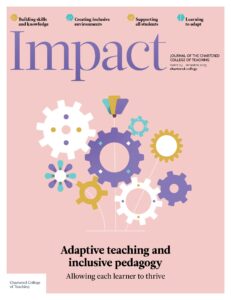Three-tiered or parallel? Contrasting approaches to inclusive education in Greece and Finland

MATTHEW TRAGHEIM, LECTURER IN PRIMARY EDUCATION, OPEN UNIVERSITY, UK
Inclusive education has been the leading educational principle in the Western world since the ratification of the Salamanca Statement in 1994 (UNESCO). Although Schuelka (2018) and, more recently, the Education Endowment Foundation (EEF, 2024) have sought to influence the depth, design and delivery of inclusive education policy in the UK, a clear definition remains rather nebulous. This reflection will focus on two recently published articles that explore the contrasting approaches to inclusive SEND (special educational needs and disabilities) education between two European countries. By identifying what defines best practice, we can consider how to meet the right of all pupils to receive an education according to their needs, within mainstream education settings and in the community with their peers (Kauffman and Hornby, 2020). This is especially pertinent considering the imminent conclusion of the diversityThe recognition of individual differences in terms of race, ethnicity, gender, sexual orientation, socio-economic status, physical ability, religious beliefs and other differences and inclusionAn approach where a school aims to ensure that all children are educated together, with support for those who require it to access the full curriculum and contribute to and participate in all aspects of school life strategy 2018 to 2025 (Home Office, 2022), the recent updates to the SEND code of practice (DfEDepartment for Education - a ministerial department responsible for children’s services and education in England, 2024) and expert panel appointments by the new Labour government.
The first article, by Eklund et al. (2020), explores the Finnish system. In Finland, a new administrative support system was launched in 2010, which aimed at promoting early support and the inclusive approach in Finnish compulsory schools (Björn et al., 2016). The three-tiered system (general support, intensified support and special support) has much in common with the well-known US ‘Response to intervention system’ (Björn et al., 2016) and supports pupils’ right to receive support according to their needs in regular classes (Finnish National Agency of Education, 2016). As a graduated approach, each of the three tiers are entered progressively, although the intention is to secure sufficient early help as the need arises. Although teachers in mainstream Finnish education are highly educated – with a master’s degree required to enter the profession – teaching pupils with learning difficulties in mainstream education has led to new competencies being required. Eklund et al. (2020) highlight that having special educational knowledge, as well as a sense of being capable of managing inclusive settings within classrooms, has a positive influence on teachers’ attitudes towards inclusion. Moreover, although Finnish teachers’ overall self-efficacy on inclusive practices is at a relatively high level, international research suggests that it is the unresolved tension between competency, capacity and consequence that most greatly impacts a practitioner’s confidence – specifically, a teacher’s belief in their competency to identify the need, their capacity to meet the need and the consequence of not being able to include all learners within their classroom. As the European Agency of Special Needs and Inclusive Education (EASNIE) (2012) suggests, teacher attitudes, knowledge and skills are all closely intertwined, and all of these influence an educator’s beliefs in their own competency. Thus, a central issue of consideration might be the competencies that best support the inclusion of diverse pupil groups within mainstream classes. Eklund et al. (2020) might argue that an inclusive teacher’s profile must principally value learner diversity and practitioner dialogue, but also trust in one’s own ability to meet a dynamic continuum of changing learner needs.
The second article, by Koutsoklenis and Papadimitriou (2021), explores the effectiveness of parallel support (PS). This is a Greek type of special education provision, aimed at providing additional support to students identified with special educational needs and/or disability in mainstream classrooms. This individualised support in mainstream classrooms is provided by the PS teachers, who are recruited as fixed-term teachers exclusively through co-financed programmes, instead of being funded by the state budget (Nteropoulou-Nterou and Slee, 2019). A strength of this approach is that the PS teachers recruited into this role are often from a diverse group in terms of teaching experience and qualifications. However, Koutsoklenis and Papadimitriou (2021) highlight that 80 per cent of primary PS teachers have no prior experience in teaching students with SEND. This issue is exacerbated by a lack of in-school induction (a process for incorporating new teachers into the school culture), mentoring (the development of strong professional relationships between an experienced and less experienced or inexperienced teacher, which facilitates discussions about teaching and school life) and professional development services available on a regular basis to the inexperienced teachers. Furthermore, Mintz et al. (2020) reports that without such support and training for novice teachers, it negatively impacts their attitudes towards inclusion, their perceived knowledge about effective inclusive strategies for inclusion and their self-efficacy with regard to their ability to include disabled students in mainstream classes. This, in turn, leads to a greater scepticism about both their role and authentic inclusion within the mainstream class.
Returning, then, to the UK, it is clear that the first Labour government in over a decade will need to lead on its own vision for inclusive education through policy reform. In a recent speech on inclusive practice, the education secretary, Bridget Phillipson, remarked that ‘a classroom that caters to all is a strength’ and ‘children thinking in different ways is a gift’ (DfE, 2025). However, there was little substantive commitment for immediate additional support, guidance or resources on effective approaches for practitioners, learners and their families. Instead, there was a broader ambition to ‘share excellence’ because ‘No child gets a second chance at childhood’ (DfE, 2025).
In this regard, two newly formed expert advisory groups to the government – one on inclusion within mainstream schools and the other on neurodivergence – have outlined a vision to deliver deeper, longer-term change, moving beyond societal perceptions of deficit, to an education system that embraces the differences of children with dignity (Chantler-Hicks, 2025). However, as Rees (2025) highlights, for dignity and inclusion to be a genuine design principle of fundamental schooling, there is a necessary prerequisite. Parents, practitioners and professionals must be able to confidently access opportunities and approaches that enhance learner outcomes as a child moves ‘upstream’ within mainstream education. This becomes ever more apropos as each learner begins to make choices about their future.
Each of the approaches advocated by Greece and Finland endeavour to create a positive and practicable approach to inclusive education. However, the extent to which they overcome deficit models, within mainstream schooling and wider society, is certainly debatable. Practitioner characteristics, clear responsibilities and collaborative opportunities for sharing excellence are all identified as ways in which to reduce complexity, increase early career teacher confidence and retain the professional experience needed to secure improved outcomes for learners. Regardless of whether the government ultimately pursues a policy akin to the three-tiered or parallel approach, it is evident that the recruitment, training, support and deployment of special education teachers and other professionals is key to realising any inclusive education system imbued with dignity.
- Björn PM, Aro MP, Koponen KT et al. (2016) The many faces of special education within RTI frameworks in the United States and Finland. Learning Disability Quarterly 39(1): 58–66.
- Chantler-Hicks L (2025) Revealed: The experts appointed to SEND inclusion panels. Schools Week, 23 January, 25. Available at: https://schoolsweek.co.uk/revealed-6-experts-appointed-to-send-inclusion-panel (accessed 20 March 2025).
- Department for Education (DfE) (2024) SEND code of practice: 0 to 25 years. Available at: www.gov.uk/government/publications/send-code-of-practice-0-to-25 (accessed 20 March).
- Department for Education (DfE) (2025) Education Secretary’s speech at the ASCL conference. Available at: www.gov.uk/government/speeches/education-secretarys-speech-at-the-ascl-conference (accessed 20 March 2025).
- Education Endowment Foundation (EEF) (2024) Supporting school attendance: Build a culture of community and belonging for pupils. Available at: https://educationendowmentfoundation.org.uk/education-evidence/leadership-and-planning/supporting-attendance/build-a-culture-of-community-and-belonging-for-pupils (accessed 20 March 2025).
- Eklund G, Sundqvist C, Lindell M et al. (2020) A study of Finnish primary school teachers’ experiences of their role and competences by implementing the three-tiered support. European Journal of Special Needs Education 36(5): 729–742.
- European Agency of Special Needs and Inclusive Education (EASNIE) (2012) Profile of inclusive teachers. Available at: https://www.european-agency.org/activities/te4i/profile-inclusive-teachers (accessed 19 March 2025).
- Finnish National Agency of Education (2016) National Core Curriculum for Basic Education 2014. Helsinki: Opetushallitus.
- Home Office (2022) Diversity and inclusion strategy 2018 to 2025. Available at: www.gov.uk/government/publications/diversity-and-inclusion-strategy-2018-to-2025 (accessed 20 March 2025).
- Kauffman JM and Hornby G (2020) Inclusive vision versus special education reality. Education Sciences 10(9): 258–267.
- Koutsoklenis A and Papadimitriou V (2021) Special education provision in Greek mainstream classrooms: Teachers’ characteristics and recruitment procedures in parallel support. International Journal of Inclusive Education 28(5): 561–576.
- Mintz J, Hick P, Solomon Y et al. (2020) The reality of reality shock for inclusion: How does teacher attitude, perceived knowledge and self-efficacy in relation to effective inclusion in the classroom change from the pre-service to novice teacher year? Teaching and Teacher Education 91(1): 1–11.
- Nteropoulou-Nterou E and Slee R (2019) A critical consideration of the changing conditions of schooling for students with disabilities in Greece and the fragility of international in local contexts. International Journal of Inclusive Education 23(7): 891–907.
- Rees T (2025) Inclusion at the heart of the school system. Schools North East. Available at: https://schoolsnortheast.org/news/inclusion-at-the-heart-of-the-school-system-tom-rees (accessed 20 March 2025).
- Schuelka M (2018) Implementing inclusive education. Available at: https://assets.publishing.service.gov.uk/media/5c6eb77340f0b647b214c599/374_Implementing_Inclusive_Education.pdf (accessed 20 March 2025).
- UNESCO (1994) The Salamanca Statement and Framework for Action on Special Needs Education. In: World Conference on Special Needs Education: Access and Quality, Salamanca, Spain, 7–10 June 1994. Available at: https://unesdoc.unesco.org/ark:/48223/pf0000098427 (accessed 20 March 2025).










